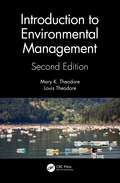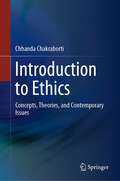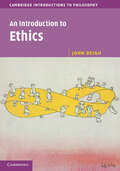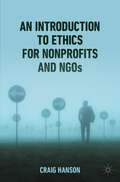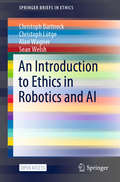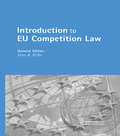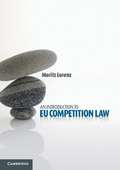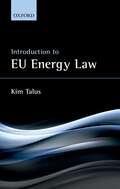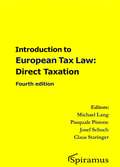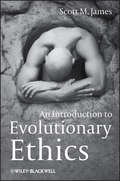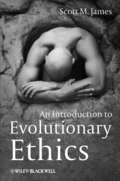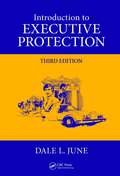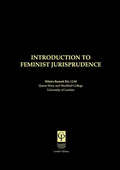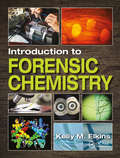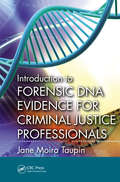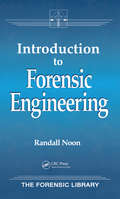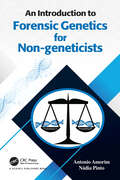- Table View
- List View
Introduction to Environmental Management
by Mary K. Theodore Louis TheodoreWritten at a level that is accessible to students in all disciplines, Introduction to Environmental Management, Second Edition translates complex environmental issues into practical and understandable terms. The book provides students and practitioners an understanding of the regulations, pollutants, and waste management issues that can be applied in various related environmental fields and industries. This new edition is updated throughout and adds eleven new chapters, including coverage of water conservation, water toxins, measurement methods, desalination, industrial ecology, legal issues, and more. Features: Updated throughout and includes eleven all-new chapters Reviews the specialized literature on pollution prevention, sustainability, and the role of optimization in water treatment and related areas, as well as references for further reading Provides illustrative examples and case studies that complement the text throughout Includes ancillary exams and a solutions manual for adopting instructors This book serves as a complete teaching tool, offering a combination of insightful coverage, concise language, and convenient pedagogical features, and supplies practical guidance that will aid students and practitioners alike.
Introduction to Environmental Management
by Mary K. Theodore Louis TheodoreWritten at a level that is accessible to students in all disciplines, Introduction to Environmental Management, Second Edition translates complex environmental issues into practical and understandable terms. The book provides students and practitioners an understanding of the regulations, pollutants, and waste management issues that can be applied in various related environmental fields and industries. This new edition is updated throughout and adds eleven new chapters, including coverage of water conservation, water toxins, measurement methods, desalination, industrial ecology, legal issues, and more. Features: Updated throughout and includes eleven all-new chapters Reviews the specialized literature on pollution prevention, sustainability, and the role of optimization in water treatment and related areas, as well as references for further reading Provides illustrative examples and case studies that complement the text throughout Includes ancillary exams and a solutions manual for adopting instructors This book serves as a complete teaching tool, offering a combination of insightful coverage, concise language, and convenient pedagogical features, and supplies practical guidance that will aid students and practitioners alike.
Introduction to Ethics: Concepts, Theories, and Contemporary Issues
by Chhanda ChakrabortiThe book introduces the reader to western ethics as a subject, along with its three standard subdivisions. Although the book is written with university students, policymakers, and professionals in mind, the book is lucid enough to be accessible to most adult readers. The book begins with introductions to the basics of ethics. These chapters are meant to provide the reader with the background knowledge necessary for understanding the more technical chapters on metaethics, normative ethics theories, and applied ethics, the three well-known subdivisions within ethics. The chapters that follow take up core ethical issues from each of these areas. The sections focus on explanation and a critical understanding of the ethical issue. The chapters also have examples, cases, and exercises to encourage critical thinking and to enable the reader to grasp the issue better. The book has tried to bring contemporary issues, such as ethics of human organ transplantation, and contemporary theories, such as Amartya Sen’s concept of Justice and Martha Nussbaum’s Capabilities Approach, to engage the readers with ethics in the real world. The book concludes with applied ethics, but with the example of ethics of artificial intelligence. The aim is to keep ethics as a future-driven activity and to emphasize the need to understand the real-world ethical situations and dilemmas that will affect the stakeholders all around the world in the coming years as artificial intelligence and data-driven technologies change our everyday life.
An Introduction to Ethics (Cambridge Introductions to Philosophy)
by null John DeighThis book examines the central questions of ethics through a study of theories of right and wrong that are found in the great ethical works of Western philosophy. It focuses on theories that continue to have a significant presence in the field. The core chapters cover egoism, the eudaimonism of Plato and Aristotle, act and rule utilitarianism, modern natural law theory, Kant's moral theory, and existentialist ethics. Readers will be introduced not only to the main ideas of each theory but to contemporary developments and defenses of those ideas. A final chapter takes up topics in meta-ethics and moral psychology. The discussions throughout draw the reader into philosophical inquiry through argument and criticism that illuminate the profundity of the questions under examination. Students will find this book to be a very helpful guide to how philosophical inquiry is undertaken as well as to what the major theories in ethics hold.
An Introduction to Ethics (Cambridge Introductions to Philosophy)
by null John DeighThis book examines the central questions of ethics through a study of theories of right and wrong that are found in the great ethical works of Western philosophy. It focuses on theories that continue to have a significant presence in the field. The core chapters cover egoism, the eudaimonism of Plato and Aristotle, act and rule utilitarianism, modern natural law theory, Kant's moral theory, and existentialist ethics. Readers will be introduced not only to the main ideas of each theory but to contemporary developments and defenses of those ideas. A final chapter takes up topics in meta-ethics and moral psychology. The discussions throughout draw the reader into philosophical inquiry through argument and criticism that illuminate the profundity of the questions under examination. Students will find this book to be a very helpful guide to how philosophical inquiry is undertaken as well as to what the major theories in ethics hold.
An Introduction to Ethics for Nonprofits and NGOs
by Craig HansonThis textbook explores ethical issues for not-for-profit and non-governmental organizations, providing discussion-oriented cases for NFP and NGP practitioners. The book begins with an introduction to professional ethics as practiced in industry, not-for-profits and NGO’s. Attention is paid both to classical ethical theories and contemporary variants. Then, combining that theory with an introduction to the morally unique facets of the NFP and NGO landscape, it offers a series of cases which pertain to the underlying theoretical substrate. The reader will find a blend of theory and application within the text as well as guided assignment prompts. Themes covered include board relationships, staff management, work with vulnerable populations, financial transparency, Human Resources ethics and ethical dilemmas unique to international operations.
An Introduction to Ethics in Robotics and AI (SpringerBriefs in Ethics)
by Christoph Bartneck Christoph Lütge Alan Wagner Sean WelshThis open access book introduces the reader to the foundations of AI and ethics. It discusses issues of trust, responsibility, liability, privacy and risk. It focuses on the interaction between people and the AI systems and Robotics they use. Designed to be accessible for a broad audience, reading this book does not require prerequisite technical, legal or philosophical expertise. Throughout, the authors use examples to illustrate the issues at hand and conclude the book with a discussion on the application areas of AI and Robotics, in particular autonomous vehicles, automatic weapon systems and biased algorithms. A list of questions and further readings is also included for students willing to explore the topic further.
Introduction to EU Competition Law
by Peter WillisThis book provides an introductory but thorough guide to EU competition law, covering the underlying economics, and the key substantive areas of anticompetitive agreements (Article 81), abuses of dominance (Article 82), the application to the most common types of commercial agreement, state aids, state measures limiting competition and mergers. It also examines the procedures under which the relevant competition authorities apply the rules, private enforcement of the rules before the courts, and minimising risk by implementing a compliance programme. The emphasis is practical rather than theoretical: the authors are practitioners in the field of competition law and economics, with many years’ individual and collective experience in the area. This will be an essential reference tool for practitioners, academics and students of EU Competition Law.
Introduction to EU Competition Law
by Peter WillisThis book provides an introductory but thorough guide to EU competition law, covering the underlying economics, and the key substantive areas of anticompetitive agreements (Article 81), abuses of dominance (Article 82), the application to the most common types of commercial agreement, state aids, state measures limiting competition and mergers. It also examines the procedures under which the relevant competition authorities apply the rules, private enforcement of the rules before the courts, and minimising risk by implementing a compliance programme. The emphasis is practical rather than theoretical: the authors are practitioners in the field of competition law and economics, with many years’ individual and collective experience in the area. This will be an essential reference tool for practitioners, academics and students of EU Competition Law.
An Introduction To EU Competition Law (PDF)
by Moritz LorenzSuccinct and concise, this textbook covers all the procedural and substantive aspects of EU competition law. It explores primary and secondary law through the prism of ECJ case law. Abuse of a dominant position and merger control are discussed and a separate chapter on cartels ensures the student receives the broadest possible perspective on the subject. In addition, the book's consistent structure aids understanding: section summaries underline key principles, questions reinforce learning and essay discussion topics encourage further exploration. By setting out the economic principles which underpin the subject, the author allows the student to engage with the complexity of competition law with confidence. Integrated examples and an uncluttered writing style make this required reading for all students of the subject.
Introduction to EU Energy Law
by Kim TalusOffering an introduction to students on the most essential elements of EU energy law and policy, this volume will be the go-to text for those seeking knowledge of EU energy regulation and its objectives, as well as an overview of energy law. Specific topics will cover the content of sector-specific energy regulation, the application and impact of general EU law on energy markets, third party access, unbundling, investment in cross-border networks, energy trading and market supervision, the application of general EU competition law on energy markets, the impact of free movement provisions, and the application of state aid rules. A structured, step by step guide through the fundamental areas of EU energy law.
Introduction to EU Energy Law
by Kim TalusOffering an introduction to students on the most essential elements of EU energy law and policy, this volume will be the go-to text for those seeking knowledge of EU energy regulation and its objectives, as well as an overview of energy law. Specific topics will cover the content of sector-specific energy regulation, the application and impact of general EU law on energy markets, third party access, unbundling, investment in cross-border networks, energy trading and market supervision, the application of general EU competition law on energy markets, the impact of free movement provisions, and the application of state aid rules. A structured, step by step guide through the fundamental areas of EU energy law.
Introduction To European Tax Law: Direct Taxation (PDF)
by Michael Lang Pasquale Pistone Josef Schuch Claus StaringerThis handbook is a concise guide for all those who aim at obtaining a basic knowledge of European tax law. Designed for students, it should be useful as well for experienced international tax specialists with little knowledge of European law, European law specialists who are reluctant to approach the technicalities of direct taxation and non-Europeans who deal with Europe for business or academic reasons and need to understand the foundations of European tax law. The authors also consider that this book can be useful to academics without a legal background in order to approach the technical issues raised by European Union tax law. This fourth edition contains changes that go beyond a mere update. In particular, it includes an enhanced analysis of the implications of the EU Charter of Fundamental Rights for direct taxes, a new chapter on European tax coordination, a focused analysis of the implications of BEPS and tax transparency for EU tax law and a stronger emphasis of developments in the field of State aids. The authors and editors trust that, with its updated content and tools, this book will remain an indispensable consultation tool also for even the most experienced European direct tax law experts. Michael Lang, professor and head of the Institute for Austrian and International Tax Law, WU Pasquale Pistone, Jean Monnet ad Personam professor at the Institute for Austrian and International Tax Law, WU and associate professor at the University of Salerno Josef Schuch, professor at the Institute for Austrian and International Tax Law, WU Claus Staringer, professor at the Institute for Austrian and International Tax Law, WU [Subject: European Law, Tax Law]
An Introduction to Evolutionary Ethics
by Scott M. JamesOffering the first general introductory text to this subject, the timely Introduction to Evolutionary Ethics reflects the most up-to-date research and current issues being debated in both psychology and philosophy. The book presents students to the areas of cognitive psychology, normative ethics, and metaethics. The first general introduction to evolutionary ethics Provides a comprehensive survey of work in three distinct areas of research: cognitive psychology, normative ethics, and metaethics Presents the most up-to-date research available in both psychology and philosophy Written in an engaging and accessible style for undergraduates and the interested general reader Discusses the evolution of morality, broadening its relevance to those studying psychology
An Introduction to Evolutionary Ethics
by Scott M. JamesOffering the first general introductory text to this subject, the timely Introduction to Evolutionary Ethics reflects the most up-to-date research and current issues being debated in both psychology and philosophy. The book presents students to the areas of cognitive psychology, normative ethics, and metaethics. The first general introduction to evolutionary ethics Provides a comprehensive survey of work in three distinct areas of research: cognitive psychology, normative ethics, and metaethics Presents the most up-to-date research available in both psychology and philosophy Written in an engaging and accessible style for undergraduates and the interested general reader Discusses the evolution of morality, broadening its relevance to those studying psychology
Introduction to Executive Protection
by Dale JuneAt a time when personal security risks are on the rise internationally, Introduction to Executive Protection, Third Edition takes readers beyond "the wizards curtain" of fear, unawareness, and surprise to give them the tools to sharpen or renew their skills so those they are tasked with protecting remain safe.This third edition of a bestselle
Introduction to Feminist Jurisprudence
by Hilaire Barnett"First Published in 1998, Routledge is an imprint of Taylor & Francis, an informa company."
Introduction to Feminist Jurisprudence
by Hilaire Barnett"First Published in 1998, Routledge is an imprint of Taylor & Francis, an informa company."
Introduction to Forensic Chemistry
by Kelly M. ElkinsChemistry/Forensic Science Forensic chemistry is a subdiscipline of forensic science, its principles guide the analyses performed in modern forensic laboratories. Forensic chemistry’s roots lie in medico-legal investigation, toxicology and microscopy and have since led the development of modern forensic analytic techniques and practices for use in a variety of applications. Introduction to Forensic Chemistry is the perfect balance of testing methods and application. Unlike other competing books on the market, coverage is neither too simplistic, nor overly advanced making the book ideal for use in both undergraduate and graduate courses. The book introduces chemical tests, spectroscopy, advanced spectroscopy, and chromatography to students. The second half of the book addresses applications and methods to analyze and interpret controlled substances, trace evidence, questioned documents, firearms, explosives, environmental contaminants, toxins, and other topics. The book looks at innovations in the field over time including the latest development of new discernible chemical reactions, instrumental tools, methods, and more. Key features: Nearly 300 full-color figures illustrating key concepts and over 20 case studies Addresses all the essential topics without extraneous or overly advanced coverage Includes full pedagogy of chapter objectives, key terms, lab problems, end of chapter questions, and additional readings to emphasize key learning points Includes chemical structures and useful spectra as examples Fulfils the forensic chemistry course requirement in FEPAC-accredited programs Includes a chapter on Chemical, Biological, Radiological, Nuclear, and Explosive (CBRNE) materials Comprehensive and accessible, without being overly technical, Introduction to Forensic Chemistry will be a welcome addition to the field and an ideal text designed for both the student user and professor in mind. Course ancillaries including an Instructor’s Manual with Test Bank and chapter PowerPoint® lecture slides are available with qualified course adoption.
Introduction to Forensic Chemistry
by Kelly M. ElkinsChemistry/Forensic Science Forensic chemistry is a subdiscipline of forensic science, its principles guide the analyses performed in modern forensic laboratories. Forensic chemistry’s roots lie in medico-legal investigation, toxicology and microscopy and have since led the development of modern forensic analytic techniques and practices for use in a variety of applications. Introduction to Forensic Chemistry is the perfect balance of testing methods and application. Unlike other competing books on the market, coverage is neither too simplistic, nor overly advanced making the book ideal for use in both undergraduate and graduate courses. The book introduces chemical tests, spectroscopy, advanced spectroscopy, and chromatography to students. The second half of the book addresses applications and methods to analyze and interpret controlled substances, trace evidence, questioned documents, firearms, explosives, environmental contaminants, toxins, and other topics. The book looks at innovations in the field over time including the latest development of new discernible chemical reactions, instrumental tools, methods, and more. Key features: Nearly 300 full-color figures illustrating key concepts and over 20 case studies Addresses all the essential topics without extraneous or overly advanced coverage Includes full pedagogy of chapter objectives, key terms, lab problems, end of chapter questions, and additional readings to emphasize key learning points Includes chemical structures and useful spectra as examples Fulfils the forensic chemistry course requirement in FEPAC-accredited programs Includes a chapter on Chemical, Biological, Radiological, Nuclear, and Explosive (CBRNE) materials Comprehensive and accessible, without being overly technical, Introduction to Forensic Chemistry will be a welcome addition to the field and an ideal text designed for both the student user and professor in mind. Course ancillaries including an Instructor’s Manual with Test Bank and chapter PowerPoint® lecture slides are available with qualified course adoption.
Introduction to Forensic DNA Evidence for Criminal Justice Professionals
by Jane Moira TaupinThe use of DNA profiling in forensic cases has been considered the most innovative technique in forensic science since fingerprinting, yet for those with limited scientific knowledge, understanding DNA enough to utilize it properly can be a daunting task. Introduction to Forensic DNA Evidence for Criminal Justice Professionals is designed for nonsc
Introduction to Forensic Engineering
by Randall K. NoonForensic engineering is generally defined as the application of engineering principles and methodology to answer questions of fact that may have legal ramifications. This new book provides an introduction to the science, methodology, and engineering principles involved in the diagnosis of some common types of accidents and failures, such as fires, explosions, automobile accidents, storm damage, industrial accidents, slips and falls, arson, water pipe damage and more. Each chapter stands alone and can be read without reference to the others. The chapters have been written so that non-technical professionals can easily digest the information and immediately apply it. The book will also be useful to technical professionals who are unfamiliar with particular investigative methodology or technical points of interest. Introduction to Forensic Engineering will benefit lawyers, insurance investigators, engineers, and other professionals who must handle investigative and legal aspects of accidents or failures.
Introduction to Forensic Engineering
by Randall K. NoonForensic engineering is generally defined as the application of engineering principles and methodology to answer questions of fact that may have legal ramifications. This new book provides an introduction to the science, methodology, and engineering principles involved in the diagnosis of some common types of accidents and failures, such as fires, explosions, automobile accidents, storm damage, industrial accidents, slips and falls, arson, water pipe damage and more. Each chapter stands alone and can be read without reference to the others. The chapters have been written so that non-technical professionals can easily digest the information and immediately apply it. The book will also be useful to technical professionals who are unfamiliar with particular investigative methodology or technical points of interest. Introduction to Forensic Engineering will benefit lawyers, insurance investigators, engineers, and other professionals who must handle investigative and legal aspects of accidents or failures.
An Introduction to Forensic Genetics for Non-geneticists
by Antonio Amorim Nádia PintoThis book aims to enable non-experts in Genetics to understand the contribution of this science to resolve civil or criminal litigations, analysing evidence of human and non-human origins. The main difficulties in the comprehension and misuse of the results of Forensic Genetics reside in the lack of effective communication between geneticists and the users of the produced information (as lawyers and judges) and do not arise primarily from the lack of knowledge of genetics. Therefore, instead of a classical handbook we use a question-and-answer approach, which meets this interfacial essence. Questions that can be addressed by genetic expertise are typified and for each of them we provide the possible expert report, presenting the essential biological and statistical genetics background in the form of boxes/appendices, along with exemplary cases. Legal, ethical, and theoretical limitations of Forensic Genetics are discussed, formulating questions that cannot, or should not, be addressed by this applied science.
An Introduction to Forensic Genetics for Non-geneticists
by Antonio Amorim Nádia PintoThis book aims to enable non-experts in Genetics to understand the contribution of this science to resolve civil or criminal litigations, analysing evidence of human and non-human origins. The main difficulties in the comprehension and misuse of the results of Forensic Genetics reside in the lack of effective communication between geneticists and the users of the produced information (as lawyers and judges) and do not arise primarily from the lack of knowledge of genetics. Therefore, instead of a classical handbook we use a question-and-answer approach, which meets this interfacial essence. Questions that can be addressed by genetic expertise are typified and for each of them we provide the possible expert report, presenting the essential biological and statistical genetics background in the form of boxes/appendices, along with exemplary cases. Legal, ethical, and theoretical limitations of Forensic Genetics are discussed, formulating questions that cannot, or should not, be addressed by this applied science.
